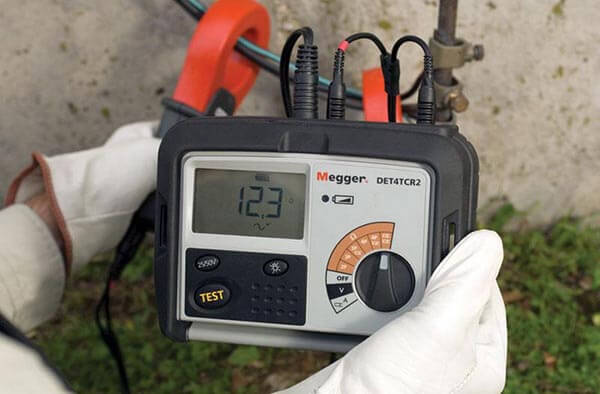How to Measure Ground Loop Resistance - Overview of Techniques
Methods Overview
Ammeter-Voltmeter Method
To conduct measurement work, it is necessary to artificially assemble an electric circuit in which current flows through the test ground electrode and the current electrode (it is also called auxiliary). Also, a potential electrode is used in this circuit, the purpose of which is to measure the voltage drop during the flow of electric current through the ground electrode. The potential electrode must be located equally far from the current electrode and the tested ground electrode, in the zone with zero potential.
To measure the resistance by the method of an ammeter-voltmeter, you must use Ohm's law. So, by the formula R = U / I we find the resistance of the ground loop. This method is well suited for measurements in a private house. To obtain the desired measuring current, you can use a welding transformer. Other types of transformers are also suitable, the secondary winding of which is not electrically connected to the primary.
Using special appliances
Immediately, we note that even for measurements at home, a multifunctional multimeter is not very suitable. To measure the resistance of the ground loop with your own hands, analog instruments are used:
- MS-08;
- M-416;
- AES-2016;
- Ф4103-М1.
Let's consider how to measure resistance with the M-416 device. First you need to make sure that the device has power. Check for batteries. If they are not, you need to take 3 batteries with a voltage of 1.5 V. As a result, we get 4.5 V. The device, ready for use, must be placed on a flat horizontal surface. Next, calibrate the device. We put it in the “control” position and, holding the red button, set the arrow to “zero”. For measurement we will use a three-clamp scheme. The auxiliary electrode and the probe rod are driven in at least half a meter into the ground. We connect the device wires to them according to the scheme.
The switch on the device is set to one of the "X1" positions. Hold the button and turn the knob until the arrow on the dial is equal to the mark “zero”. The result should be multiplied by the previously selected factor. This will be the desired value.
The video clearly demonstrates how to measure the grounding resistance of the device:
More modern digital instruments can also be used, which greatly simplify the measurement work, are more accurate and save the latest measurement results. For example, these are MRU series devices - MRU200, MRU120, MRU105, etc.
Current clamp operation
The resistance of the ground loop can also be measured with current clamps. Their advantage is that there is no need to disconnect the grounding device and use auxiliary electrodes. Thus, they allow you to quickly conduct monitoring of grounding. Consider the principle of operation of current clamps. An alternating current flows through the grounding conductor (which in this case is the secondary winding) under the influence of the primary winding of the transformer, which is located in the measuring head of the clamp. To calculate the resistance value, it is necessary to divide the value Emf secondary winding by the amount of current measured by pincers.
At home, you can use current clamps S.A 6412, C.A 6415 and C.A 6410. Learn more about how to use clamp metersYou can in our article!
Electrodeless method
This method is the most modern and allows you to measure the resistance of the circuit, without resorting to opening the grounding rods and installing additional grounding electrodes. In connection with this condition, the method has a number of additional advantages:
- the ability to make measurements in the field, in those places where it is impossible to apply other methods of measuring resistance;
- saving time and money for work.
The electrodeless method can be used if two measuring current clamps are used. For example, it can be modern testers such as Fluke 163. The pliers are placed around the ground electrode or connecting cable. In this case, the induced voltage is measured with ticks. Its amplitude is fixed by the second ticks.
The tester automatically determines the resistance of the ground loop for this connection.
Measurement Frequency
Visual inspection, measurements, and also, if necessary, partial excavation of the soil should be carried out according to the schedule that is installed at the enterprise, but at least once every 12 years. It turns out that when to make grounding measurements is up to you. If you live in a private house, then all responsibility lies with you, but it is not recommended to neglect checking and measuring resistance, since your safety directly depends on this when using electrical equipment.
When carrying out work, it is necessary to understand that in dry summer weather the most realistic measurement results can be achieved, since the soil is dry and the instruments will give the most truthful values of grounding resistances. On the contrary, if measurements are carried out in autumn or spring in wet, humid weather, the results will be somewhat distorted, since wet soil greatly affects the spreadability of the current, which, in turn, gives greater conductivity.
If you want specialists to measure protective and working grounding, then you need to contact a special electrical laboratory. At the end of the work, you will be given a protocol for measuring grounding resistance. It displays the location of the work, the purpose of the ground electrode, the seasonal correction factor, and also at what distance the electrodes are from each other. A sample protocol is provided below:
Finally, we recommend watching a video in which it is shown how to measure the ground resistance of the overhead line support:
So we reviewed the existing methods of measuring grounding resistance at home. If you do not have the appropriate skills, we recommend using the services of specialists who will do everything quickly and efficiently!
We also recommend reading:










